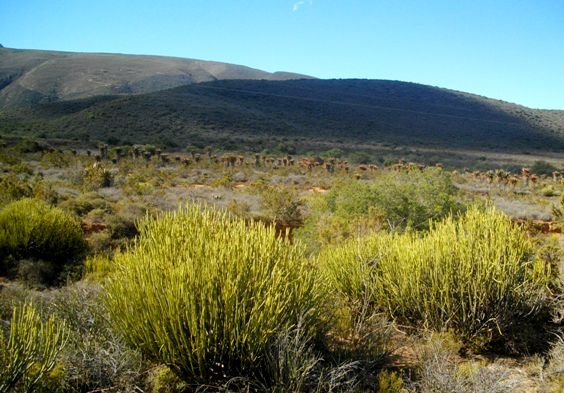Euphorbia mauritanica

Author: Ivan Lätti
Photographer: Ivan Lätti
Euphorbia mauritanica, commonly the yellow milkbush or golden spurge and in Afrikaans the beesmelkbos (cattle milkbush), is a finger succulent shrub without spines that commonly reaches heights in excess of 1,5 m. The spreading, rounded plant grows from a thick rootstock. Some form or forms of the plant are smaller with thinner stems and smaller leaves, more heavily browsed.
The much-branched, soft shrubs have smooth stems and short-lived small leaves. Milky sap appears wherever the live stems are broken.
The species distribution range is large and diverse, including almost all of South Africa apart from the provinces north of the Vaal River. It is also found in Namibia and elsewhere in southern Africa and probably further. The specific name, mauritanica, indicates initial description and naming of the plant as from Mauritania. The photo taken between Ladismith and Van Wyksdorp in the Little Karoo, shows some mature golden spurge shrubs. A large stand of Aloe ferox beckons in the distance.
The habitat is diverse, including Nama Karoo, succulent Karoo, grassland, thicket, fynbos, renosterbos and more in clay or loam soils on flats and slopes. The land carrying these plants range from coastal to inland parts varying in aridity and extremes of temperature. As farming is minimal in large tracts of this severe, semi-arid to arid land unless water is available, many succulent plants often live fairly undisturbed. The plant is sometimes browsed, but variable in palatability and some specimens are never touched by game or livestock. The species is not considered threatened in habitat early in the twenty first century (Curtis-Scott, et al, 2020; Frandsen, 2015; Smith, et al, 2017; Vlok and Schutte-Vlok, 2015; iNaturalist; http://redlist.sanbi.org).

